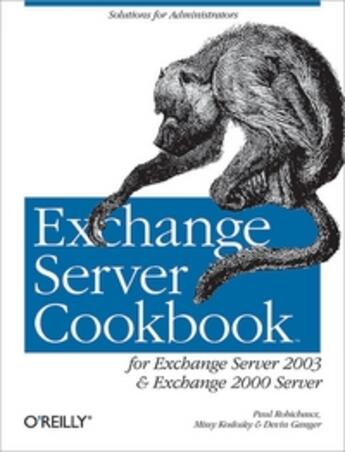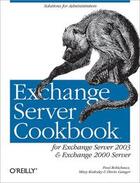-
Date de parution : 15/06/2005
-
Editeur :
O Reilly & Ass
-
EAN : 9780596007171
-
Série :
(-)
-
Support :
Papier
Résumé:
Ask network administrators what their most critical computer application is, and most will say "email" without a moment's hesitation. If you run a network powered by Windows 2000 or Windows Server 2003, Microsoft Exchange occupies much of your time. According to Microsoft, 110 million Exchange... Voir plus
Ask network administrators what their most critical computer application is, and most will say "email" without a moment's hesitation. If you run a network powered by Windows 2000 or Windows Server 2003, Microsoft Exchange occupies much of your time. According to Microsoft, 110 million Exchange seats have been deployed, but 60% of you are still running Exchange 5.5. That's a problem, because the difference between version 5.5 and the more efficient Exchange 2000 and Exchange Server 2003 is profound.
Don't fret. Exchange Server Cookbook offers you a comprehensive how-to guide to these newer versions of Exchange. You'll find quick solutions for the most common tasks you need to perform--everything from installation and maintenance to configuration and optimization, with proven recipes for the most useful tools and utilities. The book also has solutions to some uncommon tasks (that you may not know are possible) and advanced procedures that aren't part of day-to-day operations. These include tasks for critical situations, such as using a recovery storage group.
Our reliable desktop reference even shows you how to write scripts for Exchange management and deployment tasks. That's right. While not every Exchange job can be scripted, many can, and we provide lots of working VBScript examples for accomplishing particular goals. Whatever your particular need, you'll find it quickly, because chapters in this Cookbook are laid out by recipe, with cross references to other pertinent solutions in the book. With this guide, you'll learn:
The relationship between Exchange and Active Directory When to use the GUI, the command line, or scripting How to prepare forests, domains, and servers How to use Group Policy to control Exchange Diagnostic logging, measure performance, and administrative privileges Recipient management: user accounts, mailboxes, mail-enabled groups Mailbox and public folder database management Message routing and transport functions Security, backup, restore, and recovery operations For every question you have about Exchange 2000 or Exchange Server 2003, our Cookbook has the answer--one that you can find and implement without a moment's hesitation.
Donner votre avis















